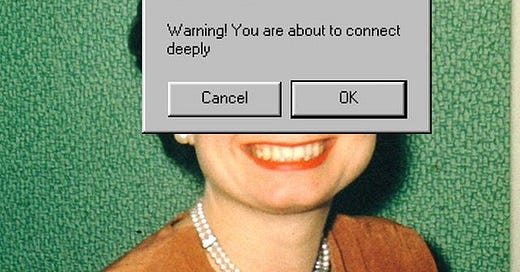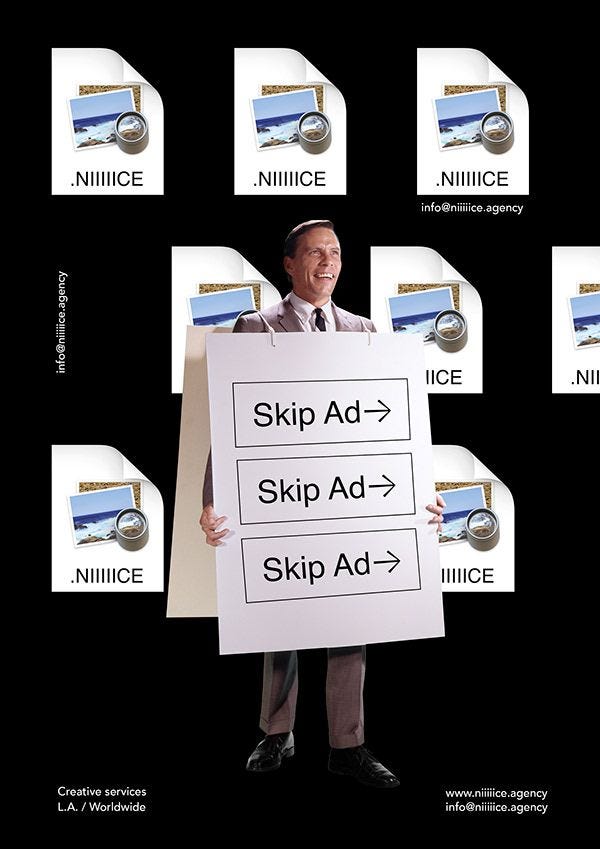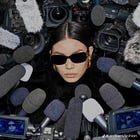The rise of the discernment premium
The attention economy, once built on more more posts, more impressions, more eyeballs is being quietly but powerfully replaced by discernment.
It’s almost wild to think that, on a daily basis, we come across around 10,000 ads.
Let that sink in.
Whether we pause to engage or immediately swipe past, the truth is we’re being sold to constantly: a product, an idea, a lifestyle, a worldview. Somewhere along the way, the line between marketing and noise completely blurred.
And it’s led to more than just fatigue.
Consumers aren’t just overwhelmed, they’re trying to de-influence each other, force themselves to disengage, and post about boycotting hauls. It’s a kind of digital self-defence mechanism.
But it’s also created something more dangerous: a low bar. We’ve accepted mediocrity in marketing because the volume has numbed our standards.
Everyone’s a marketer now….everyone’s dissecting campaigns and industry trends and when everyone’s talking at once, all saying pretty much the same thing, it’s exhausting.
I’m a marketer, and even I’m losing patience. So if I’m bored? Imagine how your consumer feels.
The Attention Economy
The attention economy, once built on more (more posts, more impressions, more eyeballs) is being quietly but powerfully replaced by discernment.
Consumers are now curating what gets their attention. They're not passively consuming anymore, they're making active choices about who earns space in their lives.
This change demands a new kind of brand strategy, one that understands that the old metrics of reach, clicks, views are no longer the whole picture.
Now, capturing attention isn’t enough anymore, you have to earn it.
Research from GWI shows that 43% of consumers are now deliberately reducing their digital consumption, and 58% say they prefer fewer, higher-quality brand interactions.
Consumer behaviour
The funny thing is, this idea of digital minimalism isn’t being driven solely by overstimulated “adults”, it’s increasingly being led by Gen Z. Yes, the same generation brands are chasing with five TikToks a day.
This generation is curating their entire life like their lives depend on it, and in some way I guess it does.
According to research from Exploding Topics, 70% of Gen Z believe they spend too much time online, and 77% have taken active steps to reduce their screen time.
They’re setting app timers.
Silencing notifications. Even creating “scroll phones”, secondary phones used only for content.They’re curating not just their wardrobes or playlists but their entire digital existence. And they expect the brands they engage with to respect those boundaries.
But it’s not just Gen Z.
Burnout from digital clutter is happening across life stages and income levels. The economic climate has added pressure, many simply can’t afford to be constantly reminded of what they don’t have.
Startups are popping up to support this mindset, apps like One Sec, which forces a delay before opening addictive apps, or Minimalist Phone, which strips your device of visual clutter to reduce overstimulation.
As I explored in my last two newsletters, the cost-of-living crisis and ongoing political instability are pushing people towards digital withdrawal. In the UK, the average Gen Z savings are around £2,000, while 60% of Gen Z adults in the US have less than $1,000 saved.
Choice paralysis crisis
Even when consumers do show up online, they’re often paralysed by decision-making. According to Deloitte, 63% of consumers have abandoned a purchase not because of price or quality, but because they simply couldn’t decide.
So you might think, “Fine, I’ll just produce more to compete with the other brands.”
Wrong.
More volume doesn’t solve choice paralysis, it compounds it.
The rise of the discernment premium
Here’s what most people get wrong: consumers aren’t always looking for the cheapest option. More often, they want the right one. One that’s going to last. One they won’t have to replace in three weeks.
The rise of fashion recycling and resale startups is no coincidence. People have overbought, and now they’re overwhelmed. The fast fashion cycle (and it’s marketing) left them with wardrobes full of low-quality items and a bad taste in their mouths.
Startups like Trashie and (Re)vive are thriving by offering a different kind of value: repair, reuse, and responsible consumption.
So, what now? what should you do?
What should you actually do?
Campaigns built for clicks can absolutely go viral. And yes, we all love a viral moment. But as I discussed in my newsletter on the rise of the infotainer, we’re in a world where click-chasing can do more harm than good.
A very random example but bare with me…If you’re a language learning app, it’s fun to post trending sounds, but what about the diaspora who struggle to speak their “home” language? The ones never taught properly? Who now feel disconnected from their roots every time they visit?
What about those experiencing racism in their workplace or in public spaces, yet don’t feel “at home” in either place, because “home” is a complicated word?
There are so many ways to speak to these people, and I’m yet to see many brands even try.
The brands built on discernment, anchored in insight, design, and strategy, build compounding trust.
According to HubSpot (2024), campaigns optimised for frequency delivered a 3.1% click-through rate but saw low retention. In contrast, lower-volume, value-first campaigns saw 2x longer engagement durations and significantly stronger conversion rates.
What does that tell us? The future of ROI lies in resonance, not reach.
NIche vs Mass debate
So what if you want to be trendy and have substance? What if you want to speak to everyone?
It depends what you mean.
If you mean showing up on LinkedIn with depth, TikTok with punchy insight, and YouTube with long-form breakdowns? That’s strategy. Same message, different tone, adapted to the platform.
But if you’re trying to be everything to everyone, flipping between Gen Z slang and Millennial memes with no real centre of gravity, then no, you’re not going to reach anyone meaningfully.
There’s no single right answer in the niche vs mass debate.
But the better question to ask is this:
What brands should actually:
If you're serious about adapting, here's what needs to happen:
Know your audience’s mood. The financial, political, and emotional landscape affects how people consume. Right now, they’re cautious and they want meaning.
Simplify your offerings: Choice fatigue is killing conversions. Be ruthless in editing what you show and when.
Respect attention: Don’t take it for granted, earn it, value it and design around it.
Create clarity, not content instead think: frameworks, explainers, toolkits. Help your audience understand, not just watch.
Work with creators who teach, not just trend. Infotainment isn’t just trendy it’s effective. If your influencer strategy still starts with “does this look cool?” you’re missing the moment.
Until next time, keep listening, keep learning, and keep evolving.
And make sure you digress often. Curiosity is key to winning in this game.
Charlotte
If you missed last week’s newsletter read it here:









Curious to hear which brands, in your view, have actually treated their customers with respect toward their discernment. Especially as a marketer who’s “lost patience.”
Also, could you please clarify the chart structure? There’s a dark blue bar that isn’t labeled, and the Boomers group appears multiple times—unsure if that’s by design or visual overlap. Grateful for your guidance.